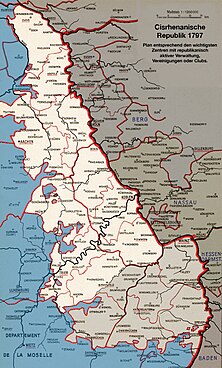Cisrhenian Republic

The Cisrhenian Republic (German: Cisrhenanische Republik) was a planned client state during the French Revolutionary Wars in 1797 on the Left Bank of the Rhine under occupation by France, where the Coup of 18 Fructidor caused a decision to annex the area instead.
History

At the beginning of the

After the levée en masse from August 1793, French forces were able to conquer vast territories on the Left Bank of the Rhine up to the 'natural Rhine border' proclaimed by Georges Danton in the National Convention. Under the terms of the 1795 Peace of Basel, the Kingdom of Prussia had been compelled to cede all her territories west of the Rhine river, but the French forces initially failed to coordinate a civil administration or to establish a Rhenish buffer state, and the ongoing occupation at the expense of the civilian population met with growing rejection. The situation did not improve until, in early 1797, the French Directory delegated General Louis Lazare Hoche to build up an orderly public administration based on the French model.
On 13 April 1797, at the suggestion of General Hoche, the Directory resolved upon the establishment of a républic separée on the west-Rhenish territories of the

In view of Napoleon's
Meanwhile, the
The French annexation was internationally announced in the 1801 Treaty of Lunéville, and the Rhineland was officially incorporated on 9 March 1801. The inclusion of the western bank of the Rhine into the French Empire also led to the Reichsdeputationshauptschluss.
Further reading
- Yvonne Kafka: Das Wendejahr 1797/8: Cisrhenanische Republik oder Annektion? [sic] Grin-Verlag für akademische Texte, München 2011, ISBN 978-3-640-96844-2.
